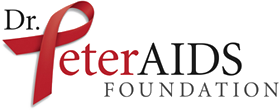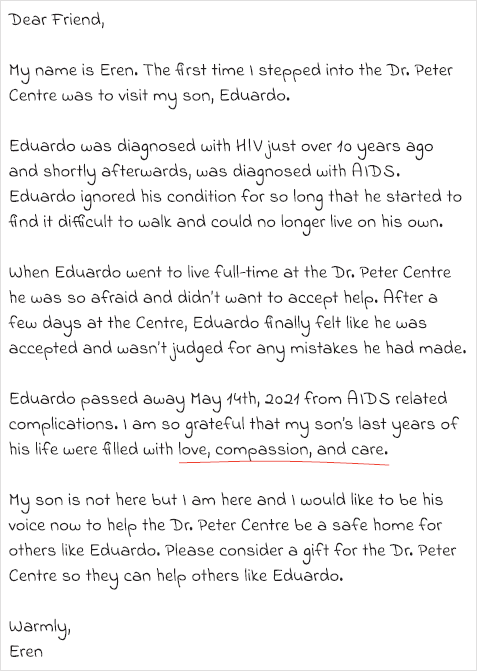Today, as For Better or For Worse® continues to run in repeats in newspapers everywhere, we begin to revisit Lawrence’s coming-out story from 1993. A storyline that saw Lynn nominated for a Pulitzer Prize, this series of strips created a massive controversy at the time—and we’re curious to see how things have changed in the 29 years since.
Read the entire sequence here in our comic archive, or follow it day by day on our Strip Fix page as it unfolds again. You can find more information about this storyline here on our website.
Read on for information on a Vancouver-based charitable organization, a letter from Lynn, and a video explaining what moved her to tell Lawrence’s story.
Introducing the Dr. Peter AIDS Foundation:
Lynn and the studio crew wanted to direct some of the attention Lawrence’s story is likely to generate to a worthy cause. Lynn selected Vancouver’s Dr. Peter AIDS Foundation.

Dr. Peter Jepson-Young was a young, gay Vancouver physician who shifted public views and brought a human face to HIV/AIDS. He chronicled his personal battle with the disease through the Dr. Peter Diaries—a weekly video diary that aired on CBC. Shortly before his death in 1992, he established the Dr. Peter Centre with the mission of providing comfort and care to people living with HIV/AIDS.
Today, the Dr. Peter Centre manages a Day Health program, a 24-hour licensed care residence with specialized nursing care, and an enhanced supportive housing program, to provide comprehensive medical care for people living with HIV/AIDS, mental illness, substance use, and homelessness. The Centre also provides healthy meals, individual counselling, personal hygiene (laundry, showers, haircuts, foot care etc.), art, music and recreational therapies, and a safe place for peer socialization, engagement, and community outings. They offer long-term support and compassionate end-of-life care. They also run a Women’s program and an Indigenous program. The clinical team sees over 25,000 health visits per year.
Since 2002, the Centre has been internationally recognized as the first health care facility in North America to integrate supervised consumption services into its model of care. This integrated model successfully engages individuals in their health care, improving adherence to HIV treatment and overall health.
If you would like to support the Dr. Peter AIDS Foundation, you may donate here. Thank you!
We are also offering signed prints from Lawrence’s story, available here in our shop, and illustrations of Michael and Lawrence, with proceeds going to the Foundation. n about this story:
A letter from Lynn:
Once I had learned how to write four panel gags, I wanted to do more. I wanted to make For Better or For Worse® realistic. Life in all its craziness is funny, frustrating, and sometimes impossibly sad. I wanted to challenge myself to address some difficult topics and the subject of “coming out” was not necessarily one of them! I was well into the storylines by 1993; my characters had developed personalities with ever-evolving friendships and experiences. I had a lot of options when it came to adventures and predicaments.
The idea to write about something “real” came unexpectedly.
One day, I decided to call an old friend to see how he was. Michael was a stand-up comic and comedy writer; someone I had known since junior high school. There was no answer. I called his stage partner, Paul, and could hardly believe what he told me. Michael had just been murdered.
With this tragedy on my mind, I wanted to do something for my friend, and everyone like him who was struggling to be understood, accepted, and loved. I decided to write a story about “coming out.” I was fortunate to have a family member who could help me with this sensitive topic. I asked my then brother-in-law to describe how it felt to tell his family he was gay. His first words were “It was a relief!” The writing began from there.
The one character who would fit well into this role was Lawrence Poirier. Easygoing, introspective and always positive, Michael’s friend was someone whose personality was yet to be defined. If Lawrence was gay, he was still the kid next door. He was still Michael’s friend and schoolmate. He had a history; he was a familiar member of the cast. For Lawrence, “coming out” was believable.
I ran the idea past my editor, Lee Salem. Lee said he thought it was a good story, but he warned me to expect some newspaper cancellations and a possible backlash. He said I might lose as many as 6 papers. I said I thought it was worth the risk and he agreed. I wrote the story as a four-week series, carefully crafting my words. We sent a letter to my client newspapers, letting them know that this story might be controversial and offering substitute strips, should they decide not to run it. Many features editors did not read the advance notice and felt blindsided when the story began to appear. None of us were prepared for what was to come.
As the Lawrence story unfolded, readers began to see where it was going and reacted with emotion and concern. Editors, too, saw this as a serious break from the comic-strip norm. This was an entertainment medium and not a forum for controversial opinions! My phone began to ring. For a month, I heard from newspaper editors and reporters. The calls went from early in the morning until late at night. Some were angry. Some were sympathetic. All were concerned and anxious. Nobody wanted to lose readers; nobody wanted to lose face! Letters came in bundles and boxes. We counted over 2500 letters. With help, I answered all that were reasonable, even the angriest. I had expected some anger, but not to the extent we were experiencing. Many of the letters were hateful and threatening.
But the letters that came from the people whose story I was telling were grateful and extremely kind. I heard from people who were able, now, to relate to family members to whom they had not spoken for years. I had letters from young people who told me their own stories and how Lawrence in the comic strip helped them to finally tell parents and friends who they were. For those four weeks, as my phone rang and the letters arrived, I wondered if I had done the right thing—and readers, overwhelmingly, were saying, “Yes, it was a good story.” It was well worth doing.
Still, many of my editors were not convinced. Those from larger cities, like staff of the Chicago Tribune, were enjoying the hype and the publicity. Editors from the smaller towns, however, were being threatened and confronted personally. “I agree with your story,” they would tell me, “but I can’t continue to run it because my house has been egged and my dog was spray-painted!” Papers began to cancel For Better or For Worse®. As the cancellations happened, rival papers, unable to buy the strip previously, were suddenly able to take it on. We lost about 40 papers and gained around 50 more!
Thinking it might be a good idea to do a study, I sent the letters to the Sociology Department of Nipissing University in North Bay, Ontario. Professors and students went through them all and announced that over 70% were positive! Of the negative responses, many were reasonable—but the threatening ones, full of hate and accusations, were from people you would never reach. These letters, these people, made me realize just how difficult it was for anyone to come out. No wonder it was taking so long to open the door to dialogue and understanding. Marginalized people were afraid—and rightly so.
The Lawrence story did a lot of good. It also ruffled a lot of feathers. In the end, after all of the controversy, I am proud of this simple and sympathetic tale. After 29 years, it is about to appear again—online and in print. I expect there will be another backlash. There will also be people who are grateful to be seen and heard. I look forward to your thoughts and opinions.
Sincerely, LJ



